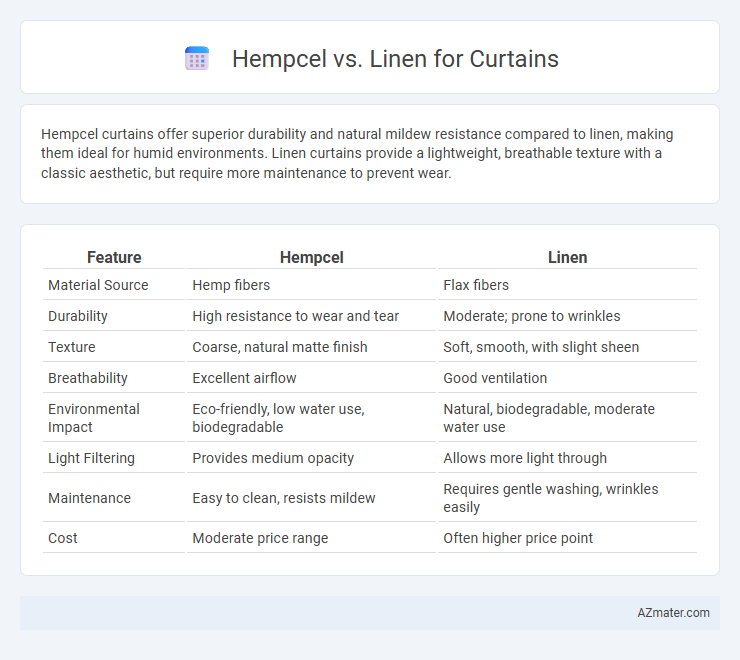Hempcel curtains offer superior durability and natural mildew resistance compared to linen, making them ideal for humid environments. Linen curtains provide a lightweight, breathable texture with a classic aesthetic, but require more maintenance to prevent wear.
Table of Comparison
| Feature | Hempcel | Linen |
|---|---|---|
| Material Source | Hemp fibers | Flax fibers |
| Durability | High resistance to wear and tear | Moderate; prone to wrinkles |
| Texture | Coarse, natural matte finish | Soft, smooth, with slight sheen |
| Breathability | Excellent airflow | Good ventilation |
| Environmental Impact | Eco-friendly, low water use, biodegradable | Natural, biodegradable, moderate water use |
| Light Filtering | Provides medium opacity | Allows more light through |
| Maintenance | Easy to clean, resists mildew | Requires gentle washing, wrinkles easily |
| Cost | Moderate price range | Often higher price point |
Introduction to Hempcel and Linen Curtains
Hempcel curtains are crafted from hemp fibers known for their durability, natural resistance to mold, and eco-friendly properties, making them a sustainable choice for window treatments. Linen curtains, derived from flax plants, offer a lightweight, breathable fabric with a distinct texture that enhances light diffusion and adds an elegant, natural aesthetic to interior spaces. Both Hempcel and Linen provide biodegradable, breathable materials that improve air quality and promote eco-conscious home decor solutions.
Material Composition: Hempcel vs Linen
Hempcel curtains are made from hemp fibers combined with cellulose, offering a durable yet eco-friendly material with natural resistance to mold and UV damage. Linen curtains consist of flax fibers known for their breathability, lightweight texture, and ability to soften over time while maintaining strength. Comparing material composition, Hempcel provides a hybrid fabric combining hemp's toughness with cellulose's smoothness, whereas linen offers a single natural fiber prized for its classic, textured appearance.
Sustainability and Eco-Friendliness Comparison
Hempcel curtains offer superior sustainability due to hemp's rapid growth cycle, minimal water usage, and natural resistance to pests, resulting in fewer harmful chemicals during cultivation compared to linen made from flax. Linen production requires more intensive water consumption and chemical treatments, impacting its overall eco-friendliness despite being biodegradable and renewable. Choosing Hempcel curtains supports lower environmental impact and promotes sustainable textile sourcing in eco-conscious home decor.
Durability and Longevity of Hempcel vs Linen
Hempcel curtains exhibit superior durability compared to linen due to their high tensile strength and natural resistance to wear and tear, making them ideal for long-term use in varying environmental conditions. Linen, while strong and breathable, tends to degrade faster under frequent exposure to sunlight and moisture, reducing its overall lifespan. Hempcel's robust fiber composition ensures extended longevity, maintaining structural integrity and appearance significantly longer than linen curtains.
Texture and Aesthetic Appeal
Hempcel curtains offer a coarse, natural texture that adds a rustic and organic aesthetic to interior spaces, making them ideal for eco-conscious designs. Linen curtains provide a smoother, softer texture with a subtle sheen, lending a refined and elegant appearance suitable for modern and classic decor styles. The choice between Hempcel and Linen impacts the overall ambiance, with Hempcel emphasizing earthy warmth and Linen highlighting understated sophistication.
Breathability and Light Filtration
Hempcel curtains offer superior breathability due to their natural fiber structure, allowing better air circulation and moisture regulation compared to linen. Linen curtains provide moderate light filtration with a tighter weave, resulting in more effective sunlight diffusion for a softly lit room. Both materials are eco-friendly, but Hempcel excels in airy comfort while linen balances light control and privacy.
Maintenance and Care Requirements
Hempcel curtains require minimal maintenance due to their natural resistance to mold and mildew, needing only occasional gentle washing to preserve texture and durability. Linen curtains, while breathable and stylish, demand careful handling with cold water washes and air drying to prevent shrinkage and maintain their crisp appearance. Both fabrics benefit from regular dusting and avoiding direct sunlight to extend their lifespan and retain vibrant colors.
Cost Analysis: Hempcel vs Linen Curtains
Hempcel curtains typically offer a more cost-effective option compared to linen, with hemp fibers costing approximately 20-30% less per yard, making hempcel ideal for budget-conscious consumers. Linen curtains, derived from flax fibers, tend to have a higher price due to their labor-intensive production process and premium texture, often priced 15-25% above hempcel fabrics. Considering durability, hempcel's resistance to wear and moisture can reduce long-term replacement costs, further enhancing its economic advantage over linen curtains.
Best Applications and Room Suitability
Hempcel curtains offer excellent durability and natural UV resistance, making them ideal for high-traffic areas such as living rooms and sunrooms where long-lasting sun protection is essential. Linen curtains provide a lightweight, breathable fabric that enhances air circulation, perfect for bedrooms and dining rooms requiring a soft, elegant aesthetic with moderate light filtration. Both materials excel in sustainability, but Hempcel suits spaces demanding resilience while Linen best fits spaces prioritizing delicate texture and airy ambiance.
Final Verdict: Choosing Between Hempcel and Linen
Hempcel offers superior durability and eco-friendliness compared to linen, making it an excellent choice for long-lasting, sustainable curtains that resist wear and tear. Linen provides a classic, lightweight texture with excellent breathability and a natural luster, ideal for bathrooms and living spaces seeking an airy ambiance. The final verdict hinges on prioritizing sustainability and strength with Hempcel or opting for the timeless elegance and softness of linen in curtain design.

Infographic: Hempcel vs Linen for Curtain
 azmater.com
azmater.com